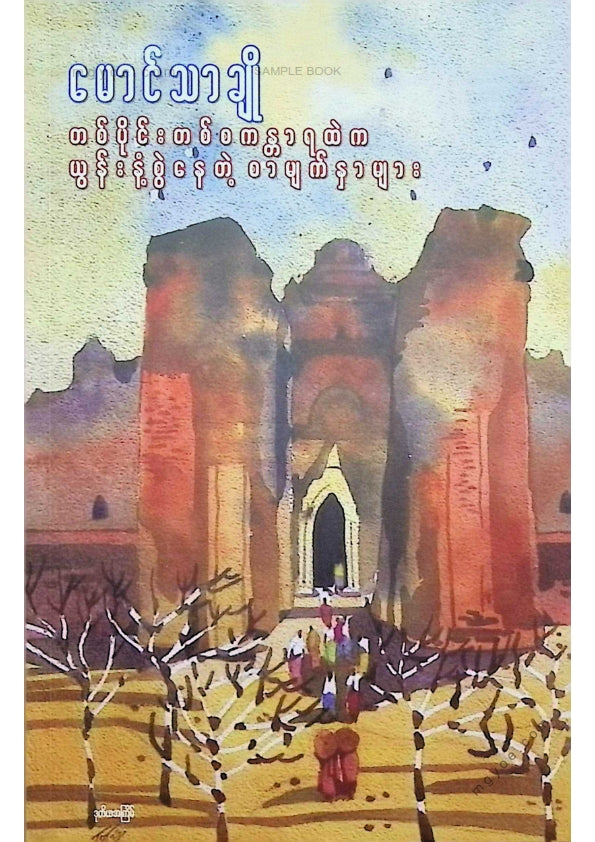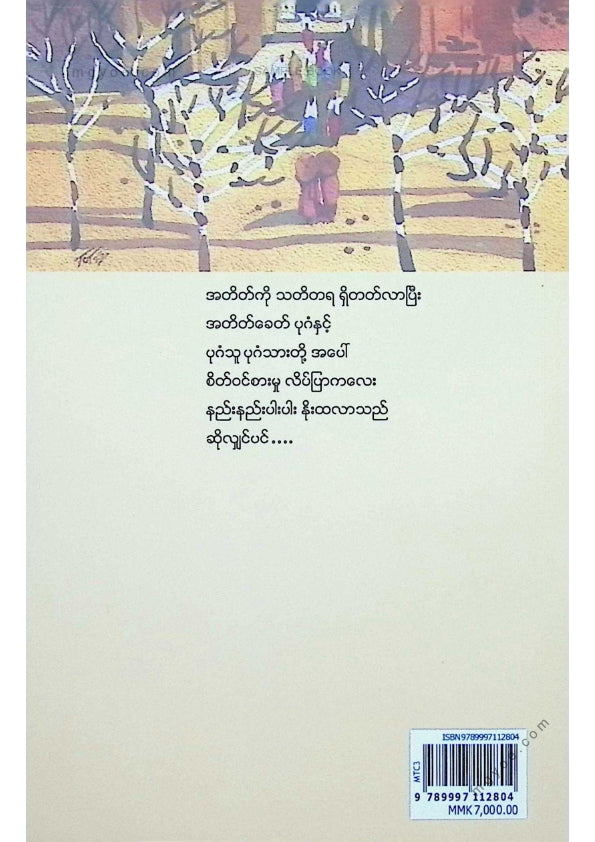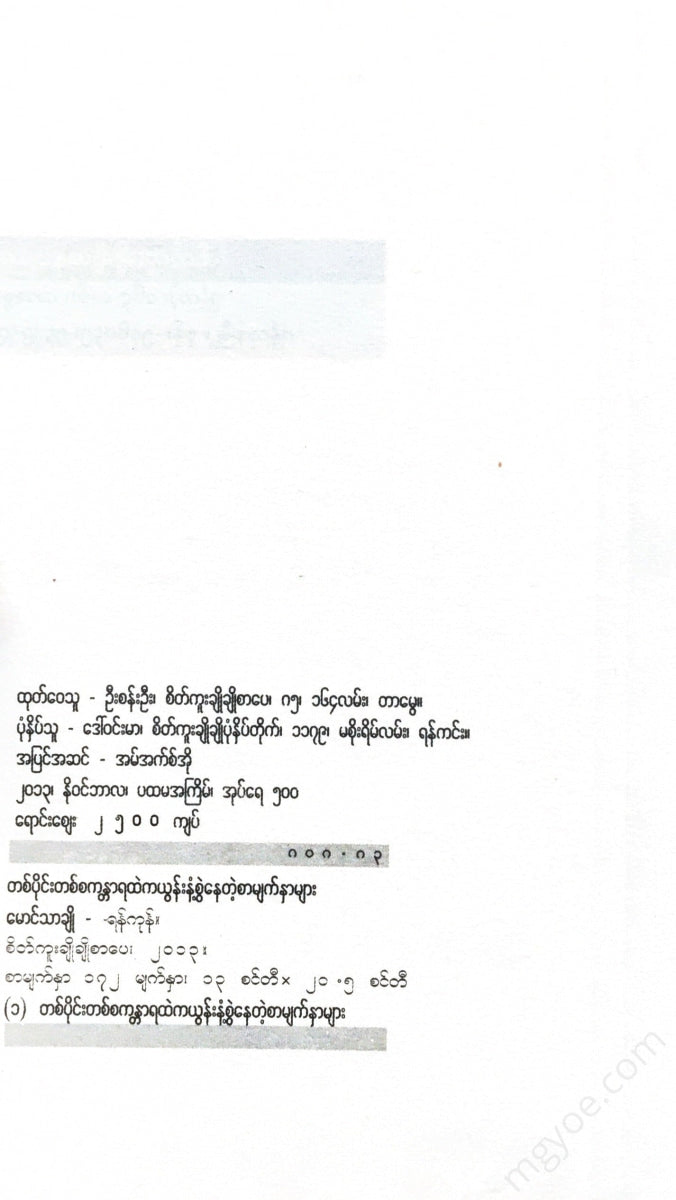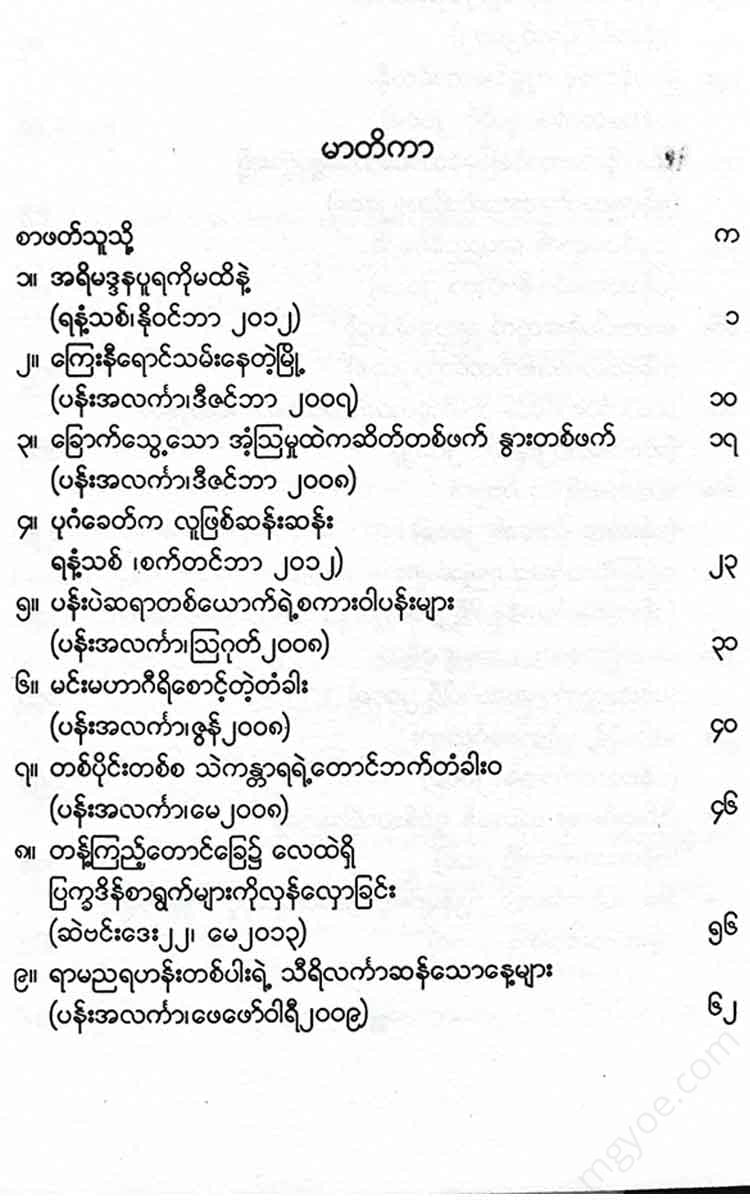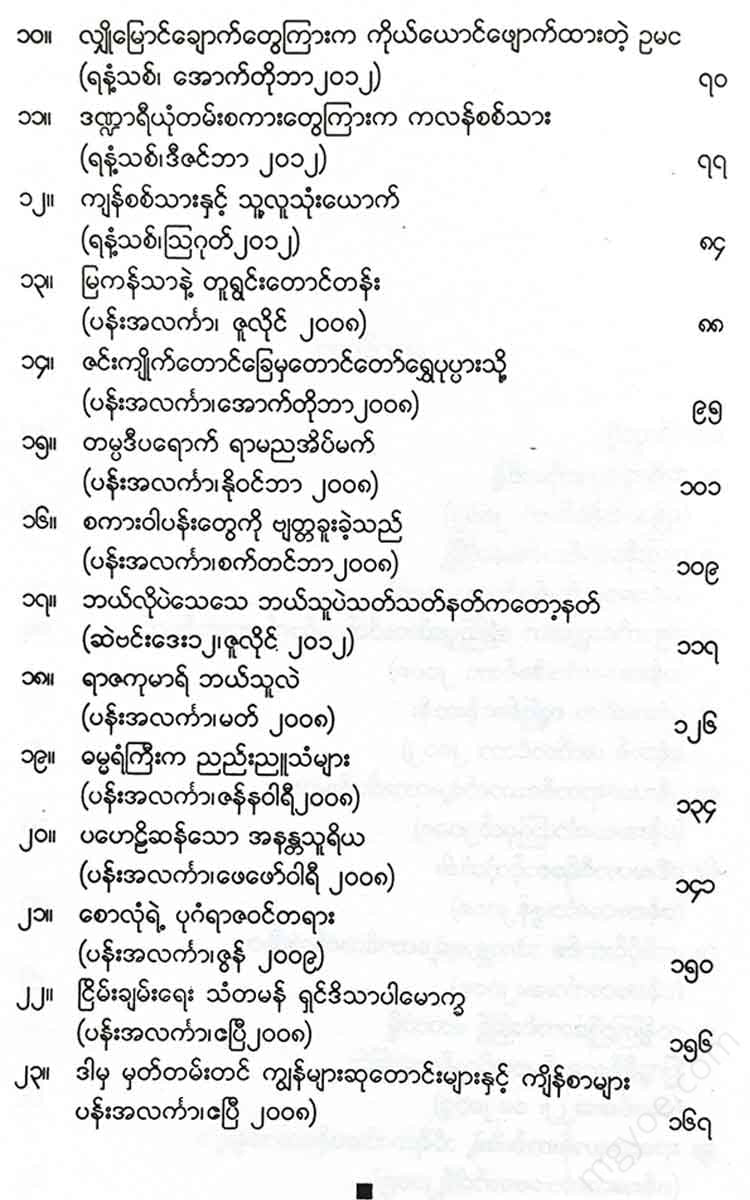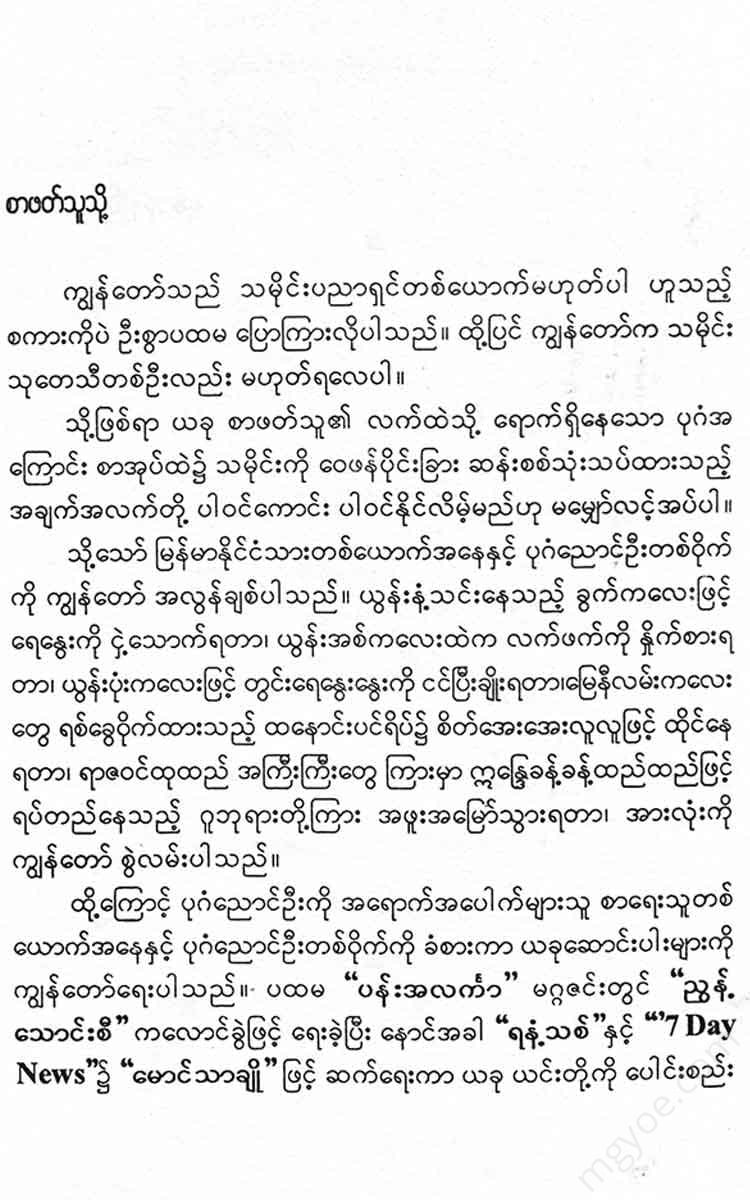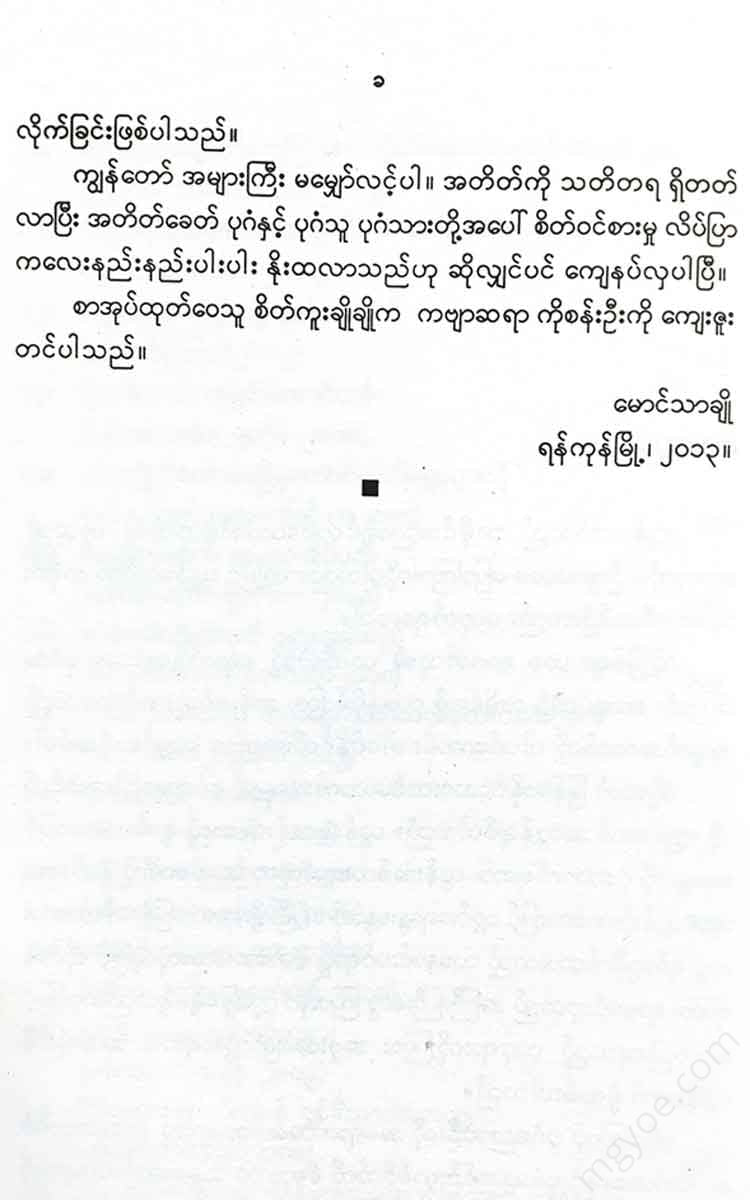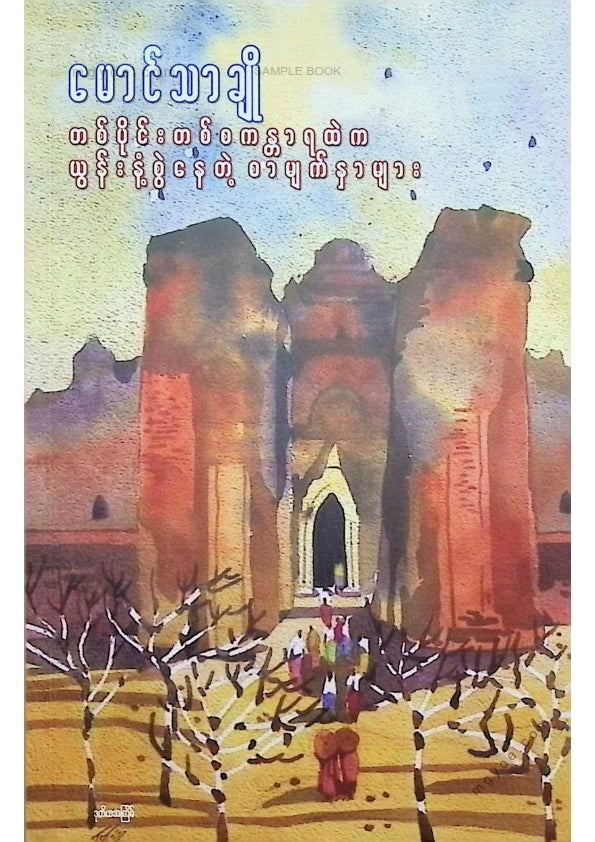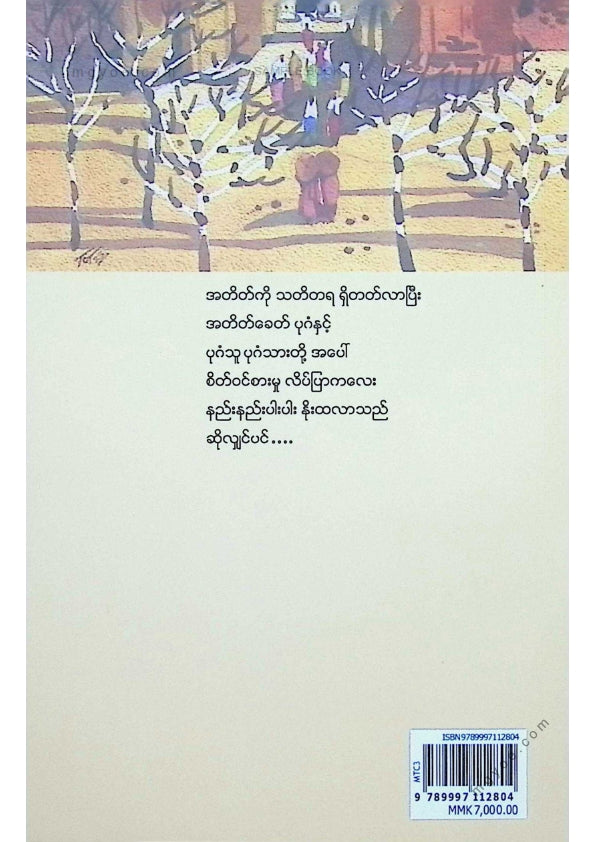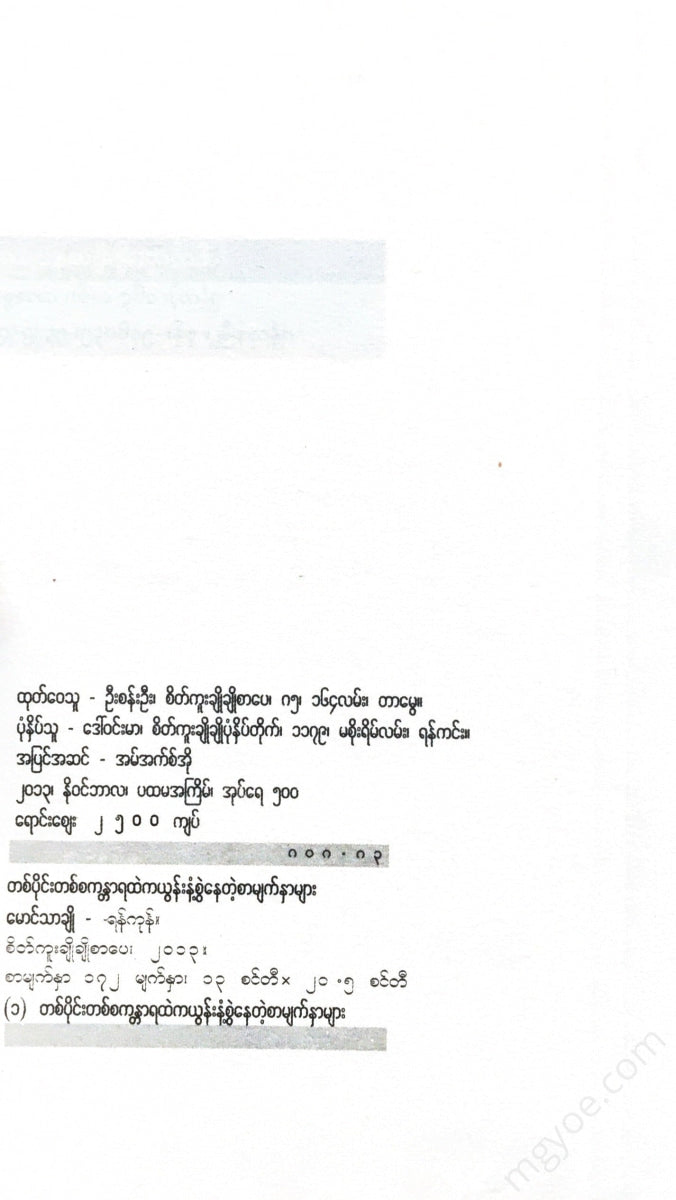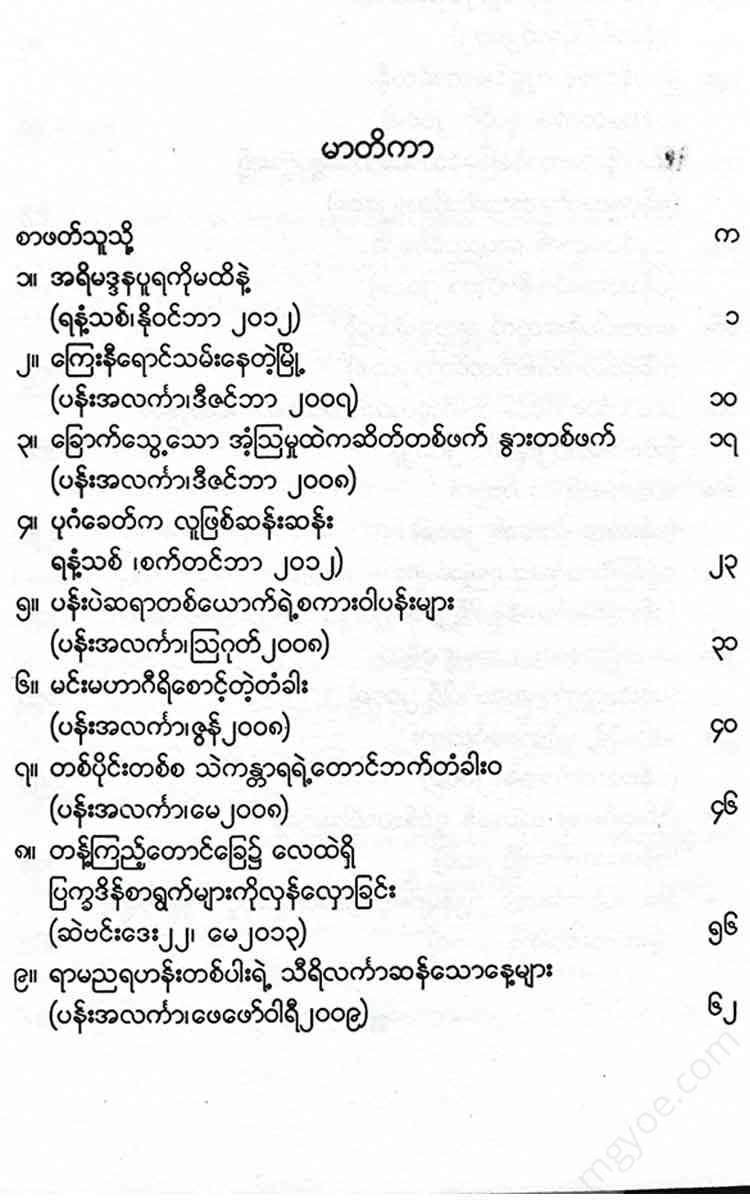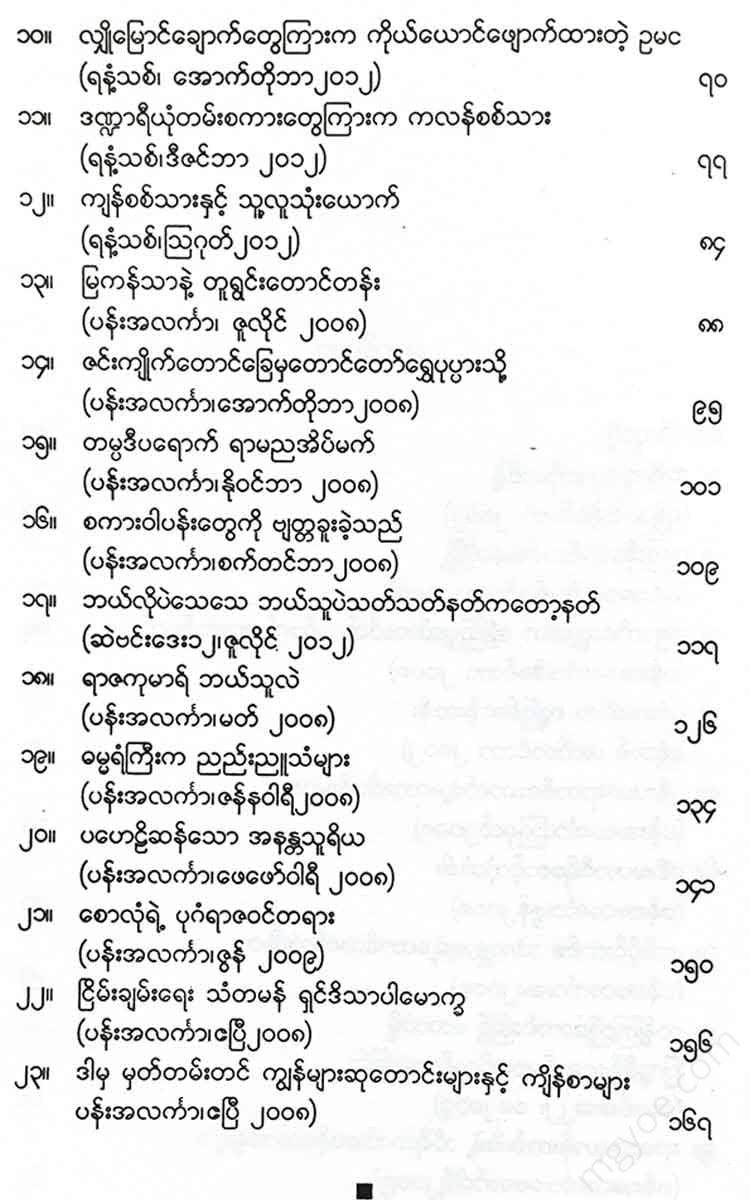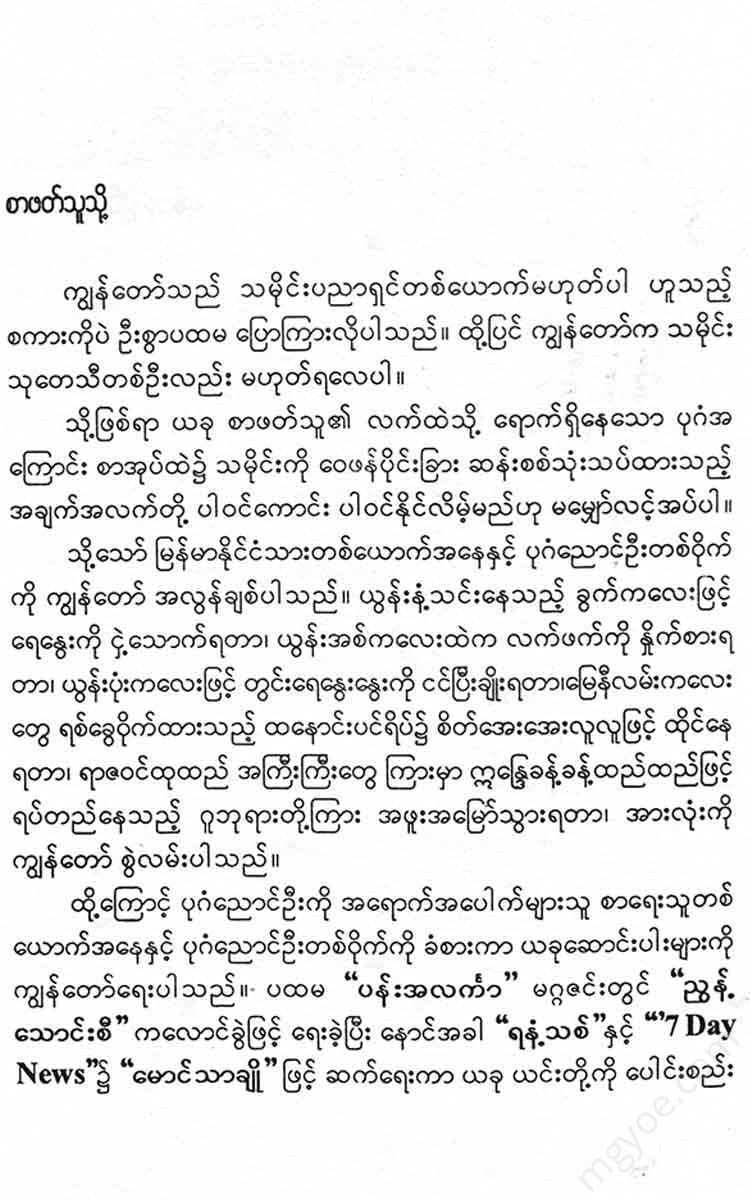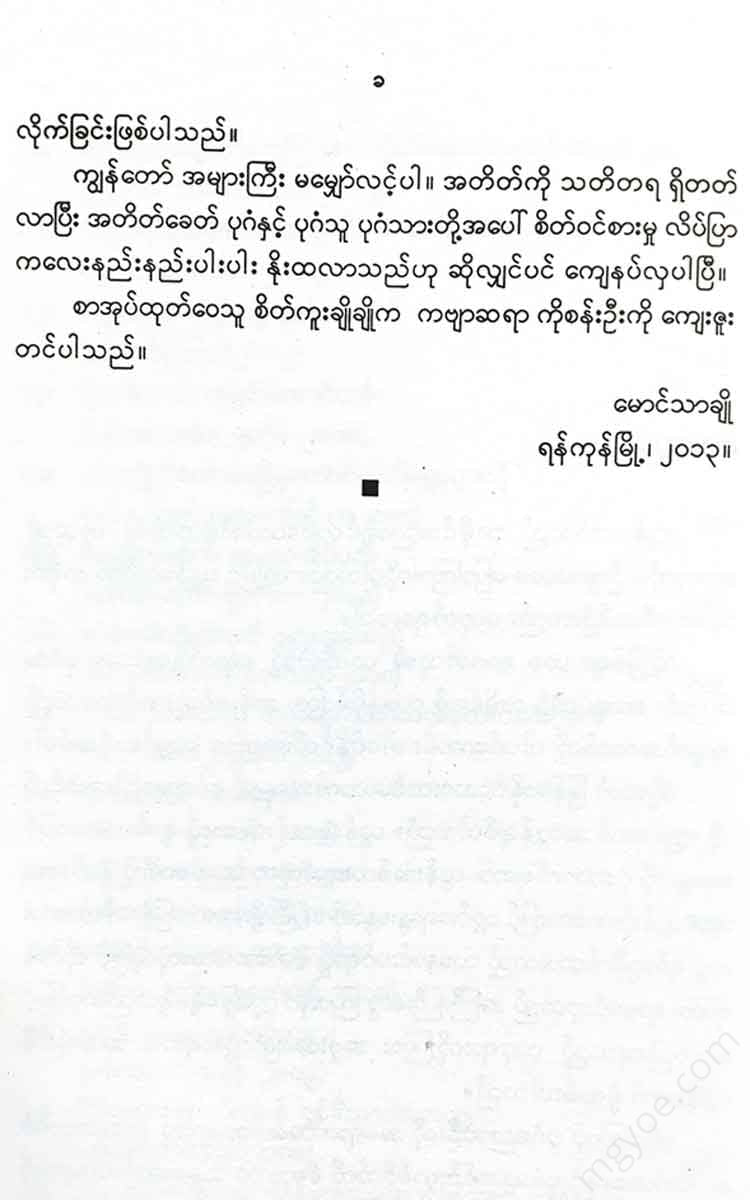စိတ်ကူးချိုချိုစာပေ
Maung Tha Cho - Pages that smell of lacquer in the desert
Maung Tha Cho - Pages that smell of lacquer in the desert
Couldn't load pickup availability
Do not touch Arimadanapura.
( one)
Bagan, which is now collectively known as Bagan, seems to have had various names in the past. In all the books I have read, I have noticed that it was written in various spellings and pronunciations, such as Pukam, Bagan, Paukam, Pukam, Bukam, Pheogama, Pugama, etc. It is difficult to say exactly when Bagan began and when it ended, with a specific date and year. However , it is widely accepted that it was a period of about 400 years, from the 9th century AD to the 13th century AD.
Many scholars have already accepted that there was a great Pyu era on the land of Myanmar before Bagan. Just read the book “Ancient Burmese Cities” by archaeologists such as U Aung Thaw, U Myint Aung, U Sein Maung Oo, and U Than Swe. Just read Major Ba Shin’s book “Myanmar Before Anawrahta”, just read the book “Where Did the Pyus Go Missing” by Dr. Than Tun, just read the book “Traces of Pre-Bagan History” by U Than Tun (Shwe Bo), just read the book “Myanmar Daily History” by the Myanmar History Research Group, just read the book “Myanmar If Pyu Were Myanmar” by Pho Tint Kyaw, it is clear that the Pyu city-states were established in the land, water, forest, and mountains, and the Pyu people flourished in that era.
When I reach Taungdwingyi, I always go to the old city of Bishno. When I reach Shwebo, I always go to the old city of Hanlin. The old city of Sri Kshetra near the village is also a frequent visitor. Walking among the Pyu beads, Pyu bone pots, Pyu jewelry, Pyu weapons, Pyu tombs, Pyu bricks, and the ruins of the Pyu city wall, I really miss the Pyu men and women who established an urban state and lived for around 800 years from the 1st century AD to the 8th century AD.
It has been mentioned in many historical documents that the ancient Pyu capital was destroyed by Vishnu in the 4th century AD, and that the ancient Hanlin and Sri Kshetra capitals were destroyed in the 8th century AD, thus ending the Pyu era.
When the rain falls, Bagan -
In the 27th century of the Pyu Dynasty, King Sugyinnagarasinda passed away. Some legends say that when the king passed away, a woman was carrying rice straw, and when the wind blew, her rice straw was blown away. Then the woman shouted, “My rice straw, my rice straw.” The people thought that the enemy army, the Mya Sakas, had come and fled, and they split into three groups: the Pyu, the Kanyam, and the Thet. One group was led by King Sugyinnagarasinda’s nephew, King Utthayasinda. The Utthayasinda was first destroyed by the Mons who established a city in Taungnyo, then by the Kanyams who established a city in Padaung, then by the Rakhines who established a city in Mindon, etc. Thus, King Utthayasinda gathered 19 Shas on the island of Yonhluttaw in AD 107 and founded the first city of Bagan. It is said that in AD 167, Pyu Saw Htee founded Arimadana, in AD 344, King Setyaung Kyaw Min founded Sripisaya at Lokananda, in AD 516, King Thaik Taing Min abandoned Sripisaya and moved to Tampawaddy (now Buksaw) and established it again, and in AD 849, during the reign of King Payn Pyay Min, it was moved to the site of the present-day old Bagan city and remained there until the fall of Bagan, etc. In this way, Bagan must have been a city that had to move its location many times even during the Bagan period.
After the destruction of the Pyu capital of Sri Ksetra, the Bagan dynasty is often described as 55 generations, from the Pyu dynasty's King Uthayan to King Saw Monic, but Dr. Than Tun describes the Bagan dynasty starting with the 42nd king, Anawrahta, who has strong chronological evidence.
1. Aniruddha (Anawrahta)
2. Givaparabarana (Saw Lu)
3. King Thi Lai (remaining soldier)
4. The first one (the body)
5. This is the Lord (Naratu) (Kalakya)
6. Narapati Sithu,
7. Na Taung (Hydeominlo)
8. Narathingwa Ujjana
9. Isa (Isa)
10. Property damage
11. Narathipa Patay (China)
12. It is called Kyaw Swar.
Dr. Than Tun did not even include Min Yin Nara Theinkha in the list of kings between Narathu and Narapati Sithu. He did not even include the kings of the Bagan era, such as Saw Nit and Saw Mon Nit, who were still alive.
In any case, neither Myanmar nor the world has denied that the Bagan era flourished magnificently, with only 55 dynasties from the Ocean King to Saw Mon, and only 12 from Anawrahta to Kyaw Swar. It is true that the rice pots of Bagan did not wither, supported by the success of the irrigated rice cultivation of the Kyaukse region 90 miles to the northeast and the Minbu region 70 miles to the south, despite being a hot and dry region.
But... Aramadanapura is a city that has overcome all enemies. A city that is loved, cherished, and valued.
( 2 years)
In Pali, the city of Maddanapura, the city of victory over the Arikas, is a city-state, so the translation of Arimaddanapura as the city of victory is a good match for Bagan.
However, Bagan was once almost in danger.
During the Second World War, from 1939 to 1945, the Japanese began to withdraw from Burma in 1945. At that time, the Allied forces led by the British entered the war with full force, and the Burmese Bagan region was not immune to the bombing and shelling. At that time, a British scholar named G.H. Luce wrote to the Allied Headquarters in Delhi, India, requesting that the ancient cultural site of Bagan not be damaged. The Allied Headquarters in Delhi listened to the scholar's words.
That's right. Dr. GH. Luce (Gordon Hannington Luce) , who was born in 1889 and died in 1979, was a scientist. Looking back at one of my notes, I see this about GH. Luce.
A native of Gloucester, England, he married Daw Tittle Louise, the sister of U Pe Maung Tin. They were married in 1915. He studied English language and classics at Cambridge University in London and received a Master's degree.
In 1912, he was a lecturer in the English Department of the Yangon Government College, in 1921 he was a lecturer in the History Department of the Yangon University, in 1953 he was a professor in the History Department of the Yangon University, and in 1956 he was the president of the Myanmar Research Association.
- Luce began studying Burmese literature, language and art in 1916. In 1928, he compiled the Bagan Stone Inscriptions with U Pe Maung Tin. From 1933 to 1956, he published five volumes of Inscriptions of Burma. In 1969-70, he published the book Old Burma Early Pagan . With U Pe Maung Tin , he translated the Glass Palace Chronicle into English. He also wrote many books on religious literature, history and culture. Therefore, G H. Luce is not at all controversial in his description of a scholar. Therefore, he has a scholar's heart. Scholars always value ancient cultural heritage that can never be replaced. In the war between the Japanese and the British, he appealed to the Allied Headquarters in Delhi not to bomb Bagan with artillery or bombs. Don't touch Bagan. Since the educated English didn't touch it, the civilized English armed forces didn't touch it either.
In honor of this gift, Saya Min Thuwan composed a poem. A poem in honor of Professor Dr. G.H. Luce, whose Burmese name is Welu....
Bagan and Velu
All around the north, the snowy mountains
Passing by, singing,
The great army, the fire of Asia
Coming out of the closet, facing each other
With gentle love, just words
The blue sky, the peaceful breeze,
Hloan Mook Cave Temple, Buddhas
If the sun does not fade, it stands firm.
The radiant light, the shining light
The Golden Land of Bagan survived.
In our time, the world is at war.
Burning, on land and in water
In heaven, there is no escape.
The fire is burning, my mother is burning.
I miss my father, I'm exhausted.
Ma Chan Kyi Naing, while giving up
To the throne of Meru, to the city of Kor,
Teacher Velu, please prohibit it.
Pokkaram, without any harm.
Myanmar's pride, shining brightly
It is a sign that the five thousand will be established.
The meaning of the poem is clear. During the reign of the Chinese exile king Narathihapat, Shindisa Pamauk was able to stop the Chinese army from advancing with words of peace, and Bagan was saved. The meaning is that GH. Luce saved Bagan from being burned by the flames of the allied war.
Although the number of pagodas is not as large as the Hle Win Xo Than Tan Nyam Nyam (4446733) and Wa Wa Win Win (4444) mentioned in oral history, the number of pagodas that have survived to this day, as counted by archeologists as 2217, is partly due to GH. Luce.
Dr. Than Tun said that he doesn’t like Bagan being renovated or rebuilt, he likes to keep it as it is. My friend, the artist Maung Dee, said that it is a paradise. That’s right. The mountains are green and lush. The red roads are winding. The Taungdaw Shwe Poppa, the Tu Rong Mountain and the Tan Kyaw Mountain are surrounded by it. The Myit Min Aya is a beautiful place. When the wind is blowing, walking among the Hintha Pada pagodas, temples, and pagodas is like walking in a paradise. Such a great past, such a magnificent history, such an artistic past, such a bright past. I don’t think we will ever get it back.
Aw.. same as life, Bagan..
To the reader
Let me first say that I am not a historian. Furthermore, I am not a historical researcher.
Therefore, it is not expected that the book on Bagan that is now in the hands of the reader will contain information that critically analyzes history.
However, as a Burmese, I love the area around Bagan Nyaung U very much. I love drinking hot water from a small cup that smells of lacquer, sipping tea from a small lacquer pot, taking a bath in a small lacquer bucket, sitting peacefully in the shade of the red-earthed trees that weave through the narrow streets, and wandering among the magnificent pagodas standing in a unique way among the huge historical monuments. I am addicted to it all.
Therefore, as a writer who has visited Bagan Nyaung U many times, I write these articles with the feeling of the surroundings of Bagan Nyaung U. The first “Pan Alanka” magazine featured “Nyaung U”
I wrote under the pen name “Thousands of People” and later continued to write under the pen name “Maung Tha Cho” in “Yaant Thit” and “7 Day | News”, and now I have combined them.
I don't expect much. I'm satisfied that I've become more aware of the past and have awakened a little bit of interest in Bagan and its people of the past.
The publisher of the book, Iyin Cho Cho, would like to thank the poet Ko San Oo.
Maung Thar Cho, Yangon, 2013.
